This post may contain affiliate links. Read our disclosure policy.
Homemade pie crusts are about a thousand times more flavorful, flaky, and tender than the store-bought kind. It takes a little bit of extra work to get a perfect pie crust, but it absolutely does not need to be as intimidating as it may seem.
Until the dough comes together in a cohesive ball, it seems like something has gone wrong. Not to mention all of the frustrations when pie dough shrinks or loses its shape after baking. I’ve factored in as many potential pie crust woes into this recipe to make it as foolproof as possible.
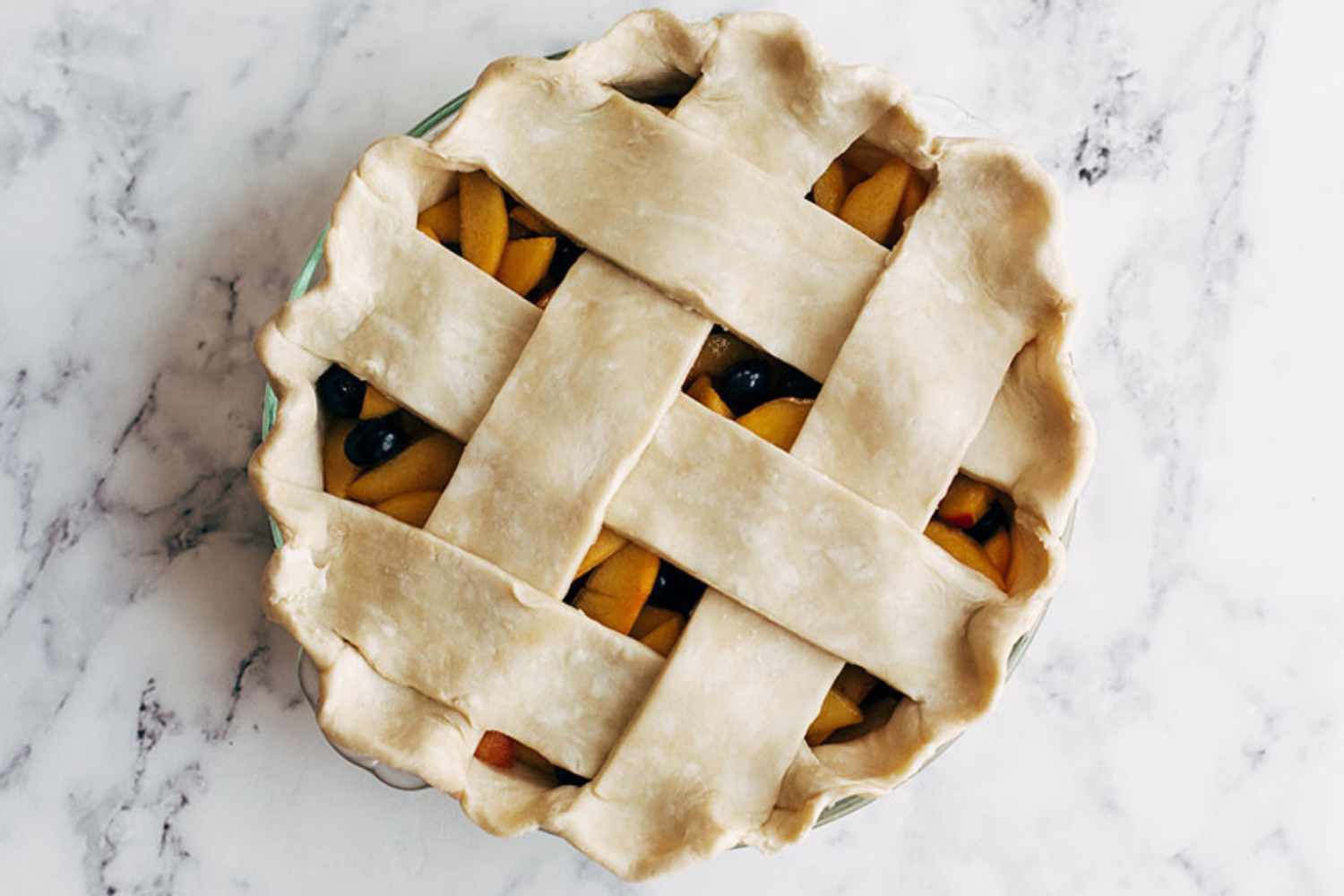
I actually completely overhauled my pie crust recipe in 2020 to make it even more tender and flaky. I took a bunch of feedback I’d received over the years from readers to improve the recipe and I’m SO happy with the results. Take a look at just how FLAKY:

I spent weeks testing, experimenting, and researching different pie dough methods, tips, and tricks. Some worked, others didn’t.
I’m sharing a ton of tips that truly work in this post, so let’s go ahead and get right into the juicy stuff. (Or should I say flaky stuff?)
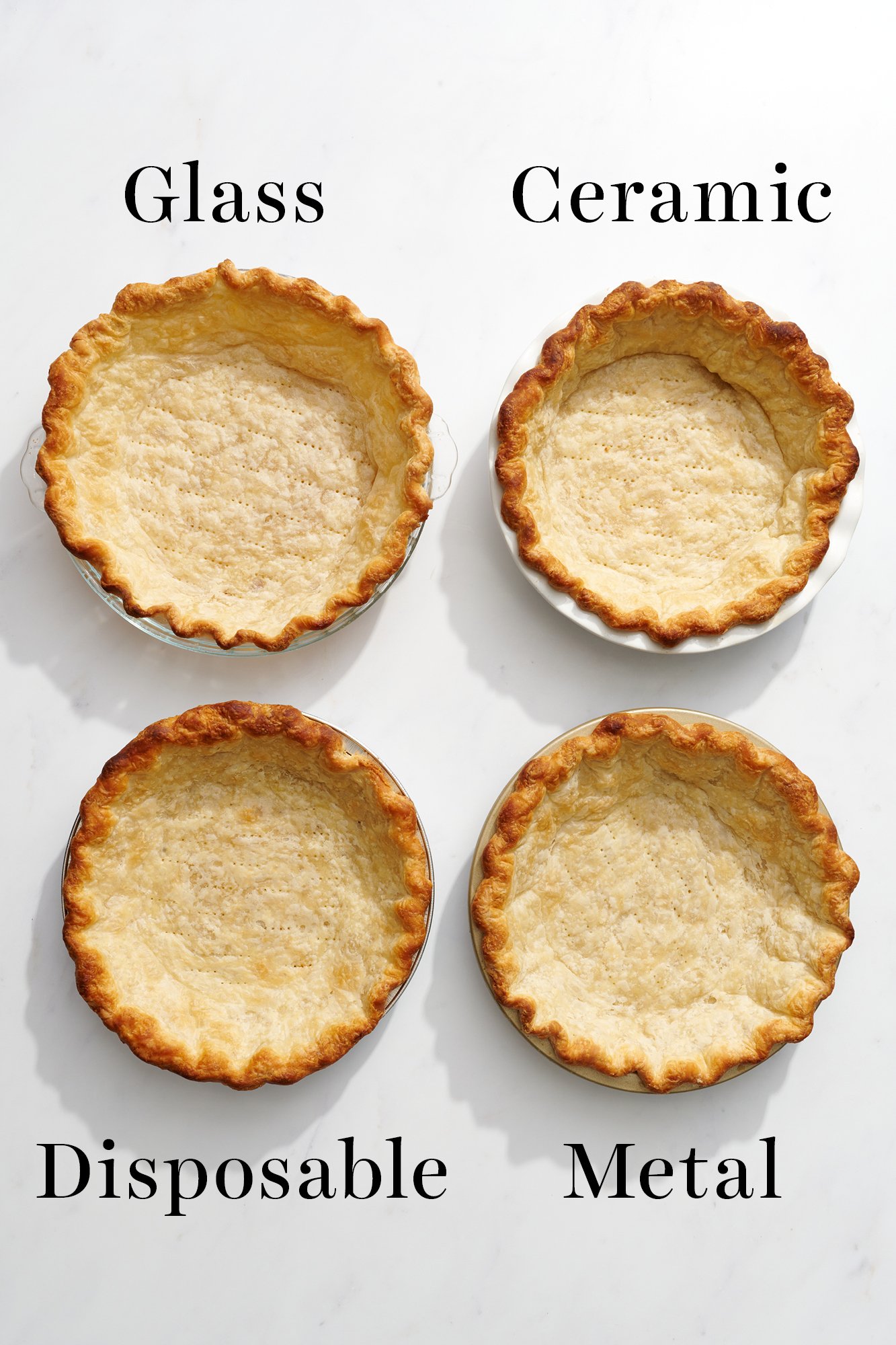
How to Make the Best Ever Pie Crust
For Flaky Pie Crust, Keep Everything COLD, Especially Your Butter
If your kitchen is above 73°F, you can refrigerate all of your ingredients and equipment including your bowl, rolling pin, and pie plate until it’s between 65-70°F (dip an instant-read thermometer into your flour to gauge the temperature). If it’s a hot day, or you have hot hands, you’re probably better off making your pie dough in a food processor.
If your kitchen is warm, fill freezer bags with ice and a little water and set them on your work surface for 10 minutes to chill it before rolling out your pie dough. This will prevent the butter from becoming greasy as you work with the dough.
Pea-Sized vs. Large Chunks of Butter in Pie Dough
- The general rule of thumb is that smaller pieces of butter will result in a more mealy textured crust that holds up better to custard fillings.
- Larger chunks of butter will yield a flakier crust better suited for fruit fillings. Larger chunks also run the risk of creating pools of butter as your pie dough bakes.
- Overall, the differences can look relatively minor from a visual perspective once the crusts are baked.
- If you don’t have a ton of pie dough experience or confidence, I’d recommend small pieces of butter. It makes the dough much easier to work with!
- Take a look at what a difference it makes to use pea-sized vs. large chunks of butter in pie crust:
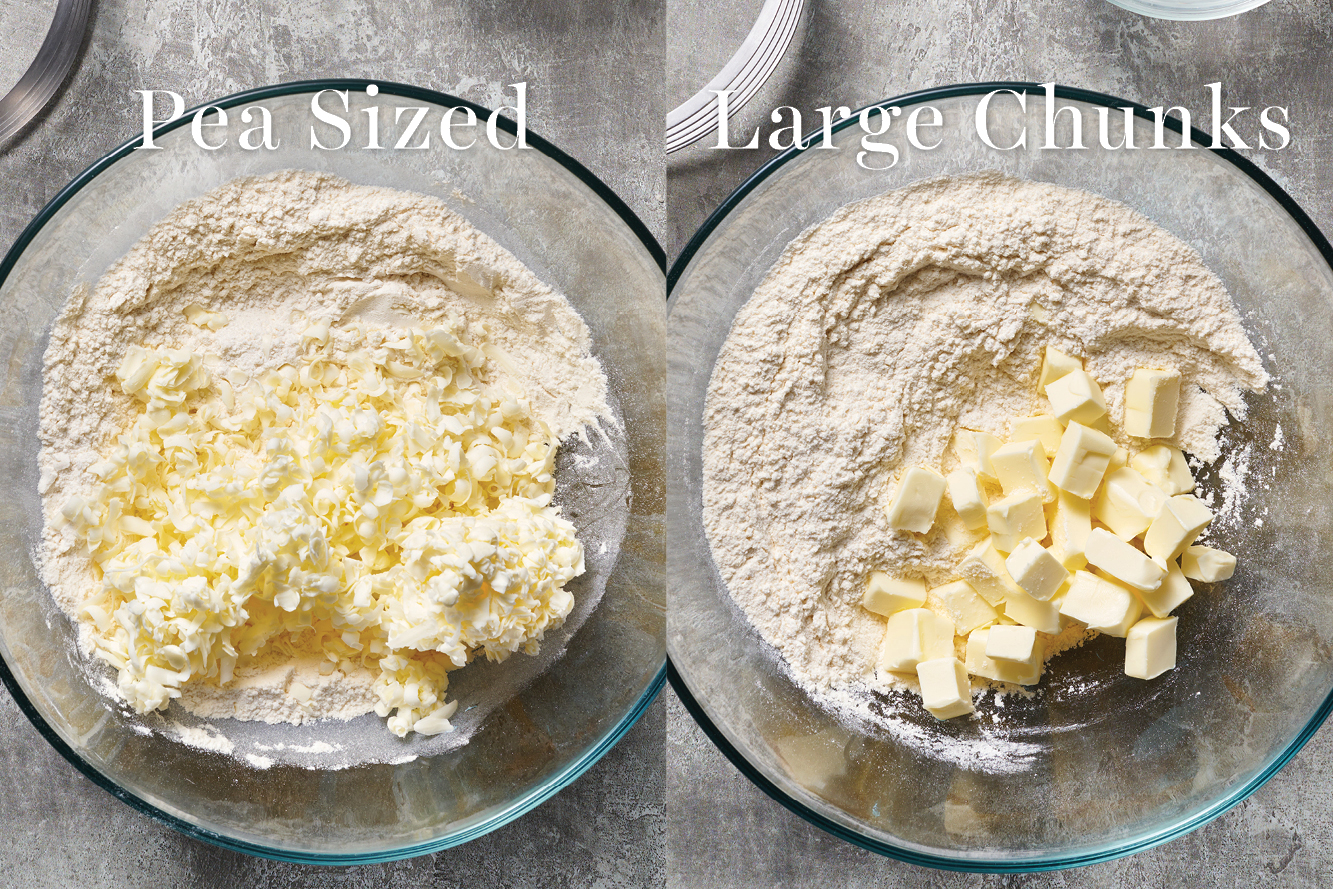
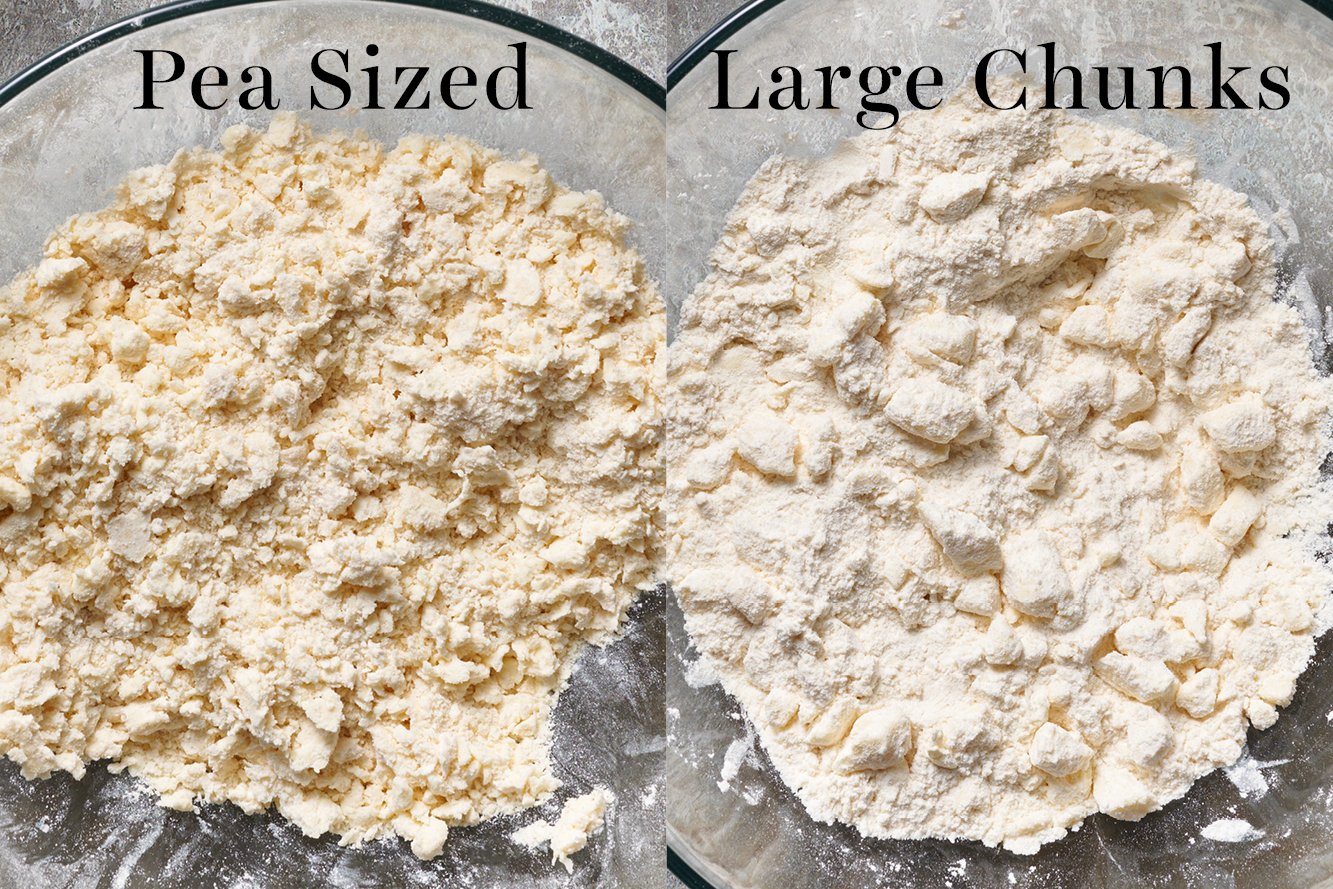
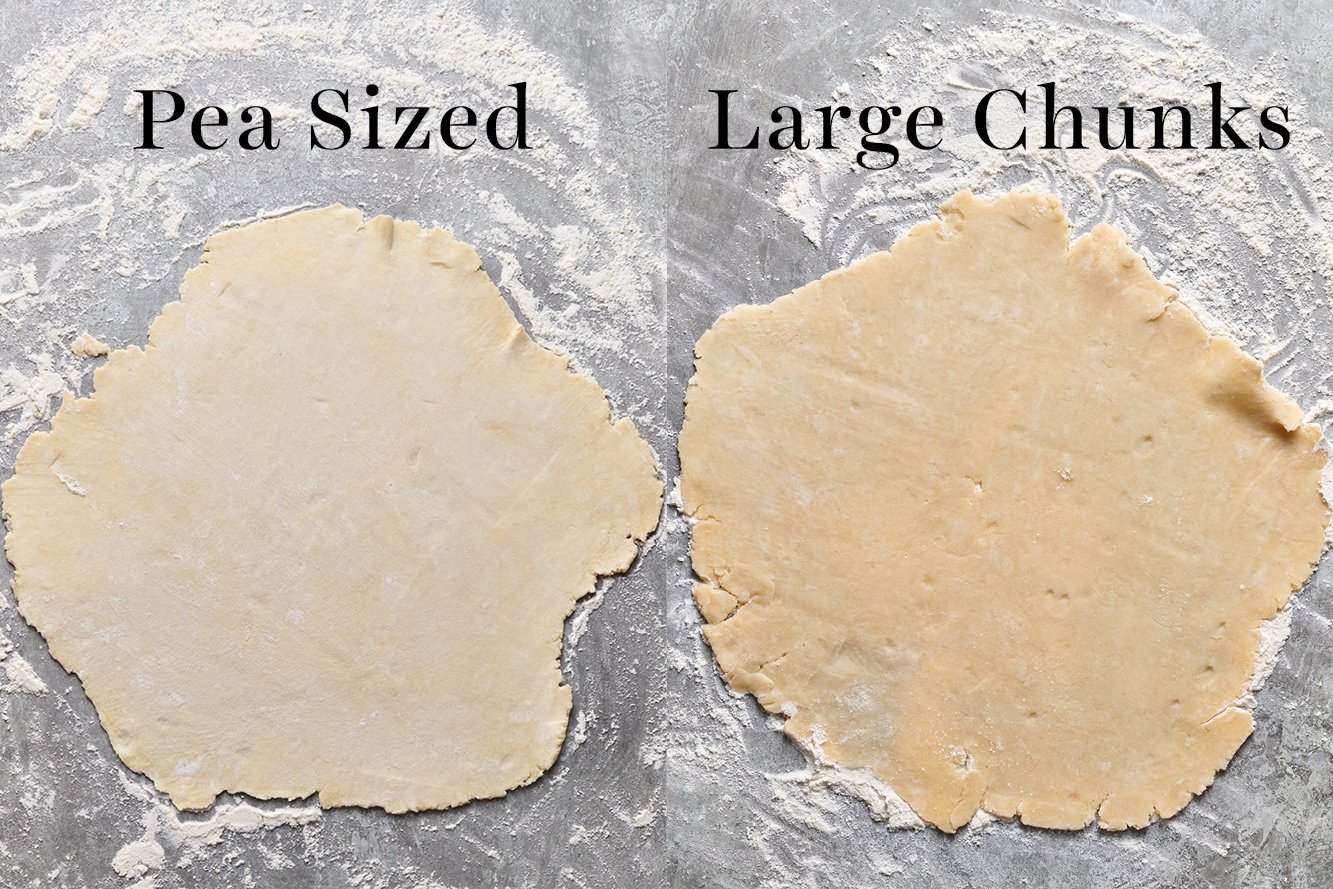
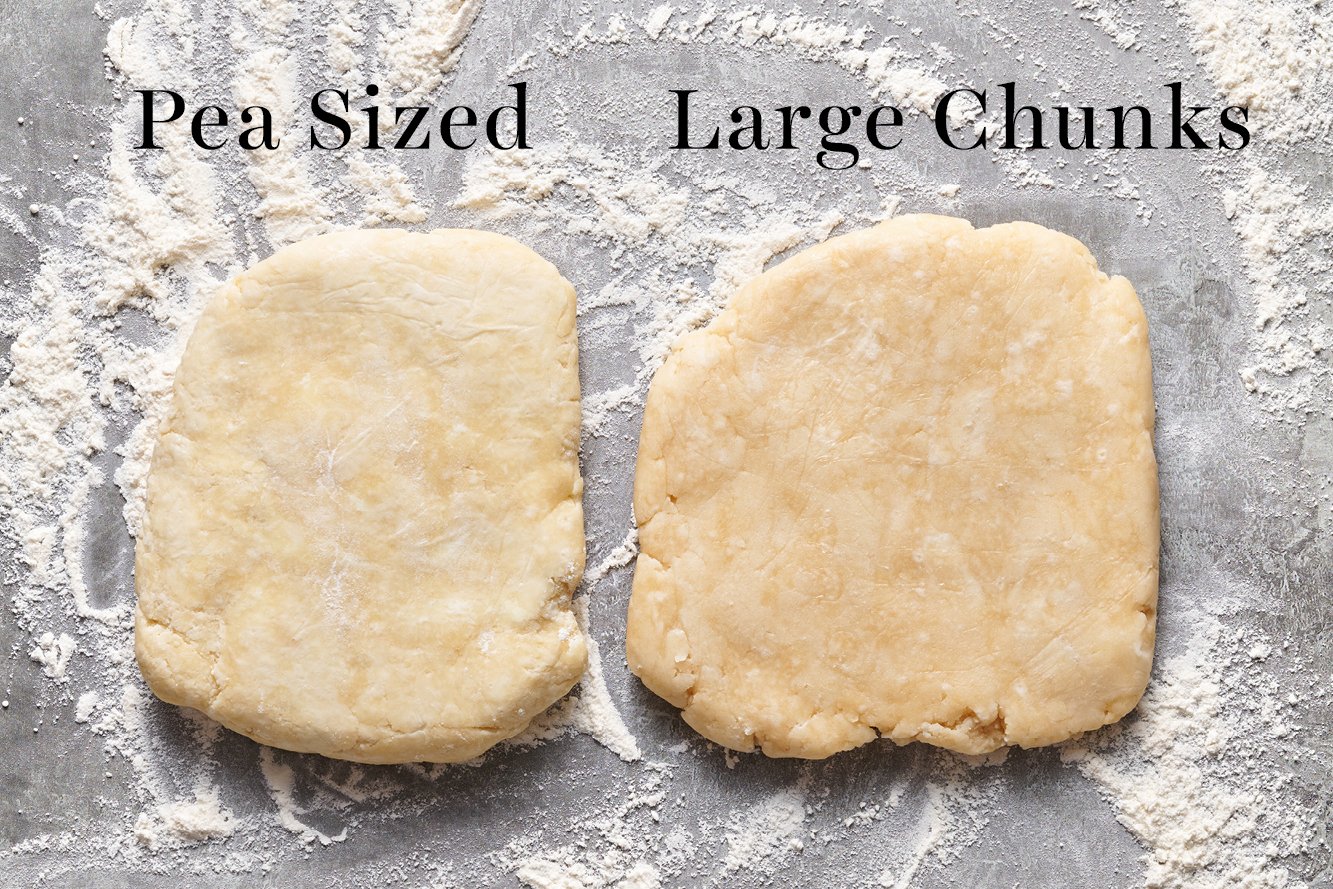
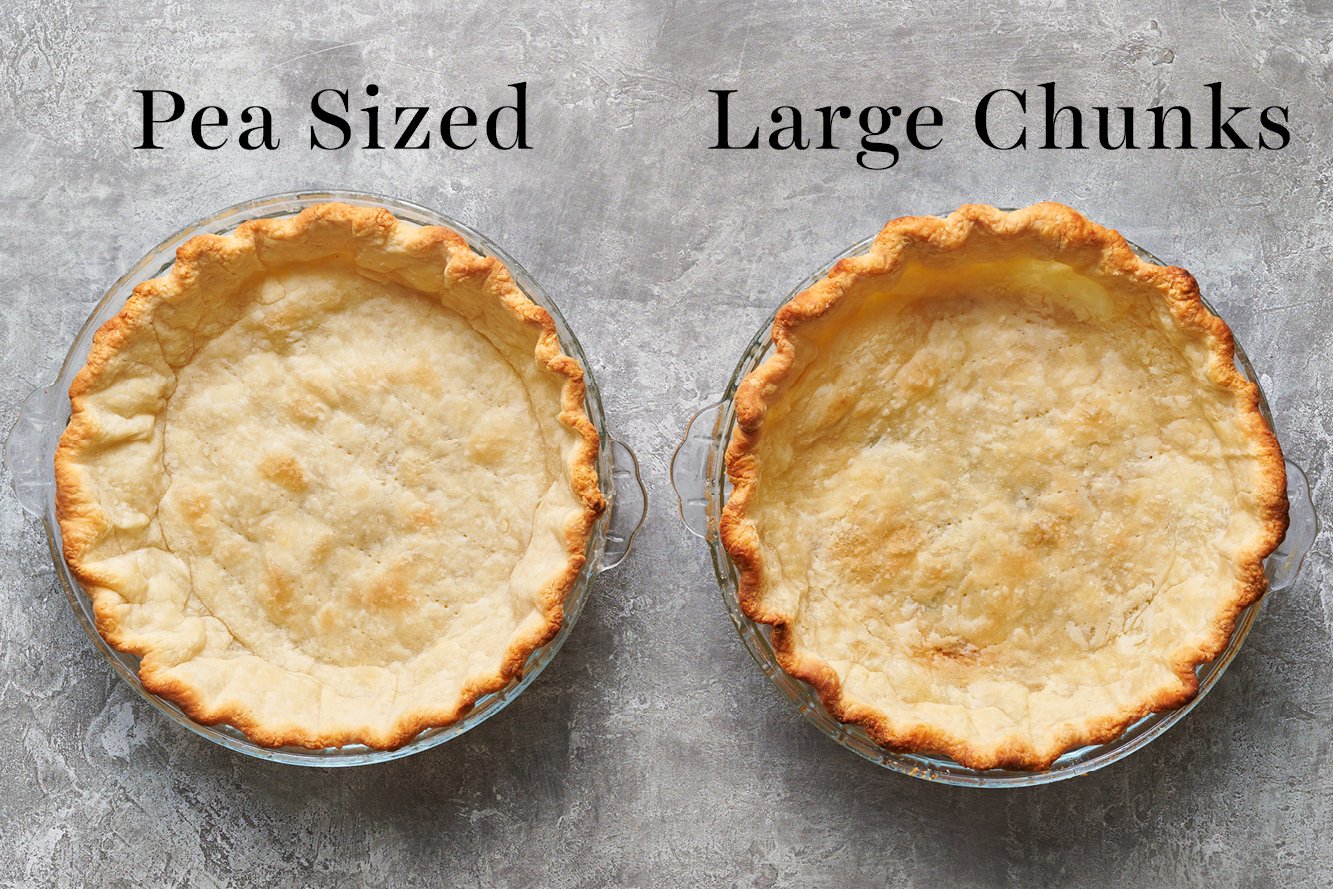
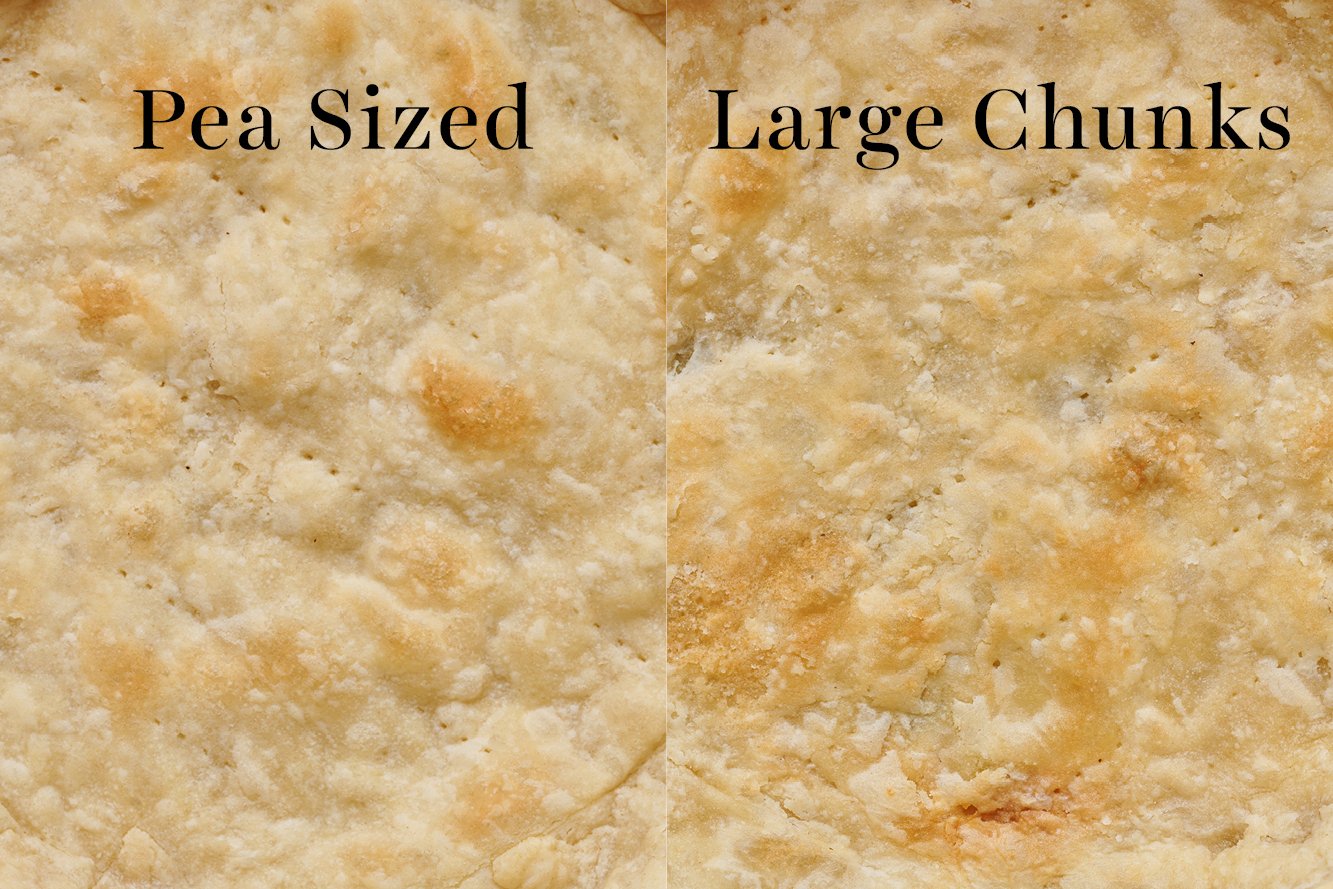
Cut the Butter Into Small Uniform Pieces
It should take just a couple of minutes to cut the butter into the flour mixture so you don’t risk the butter getting too hot. For this reason, it’s helpful to start out with pieces of butter that are already small in size. I’ve included several options for processing the butter below. My personal favorite is to grate it like cheese!

Method 1: Grater or Knife
Take your butter and freeze it for about 10 minutes, or until it’s super cold and firm. Using the large holes on a grater, literally grate the butter like cheese. If you have it, you can use the grater attachment on your food processor, but otherwise use the large holes on a box grater. Return the grated butter to the freezer for another 10 minutes until it’s firm before adding into the flour mixture.
If you don’t have a box grater, freeze your butter for even longer, until firm, then use a sharp knife or bench scraper to slice it into chunks.
Working quickly, use your hands to further cut and break the butter into pieces the size of small peas. You can also use a pastry cutter/blender or two knives.
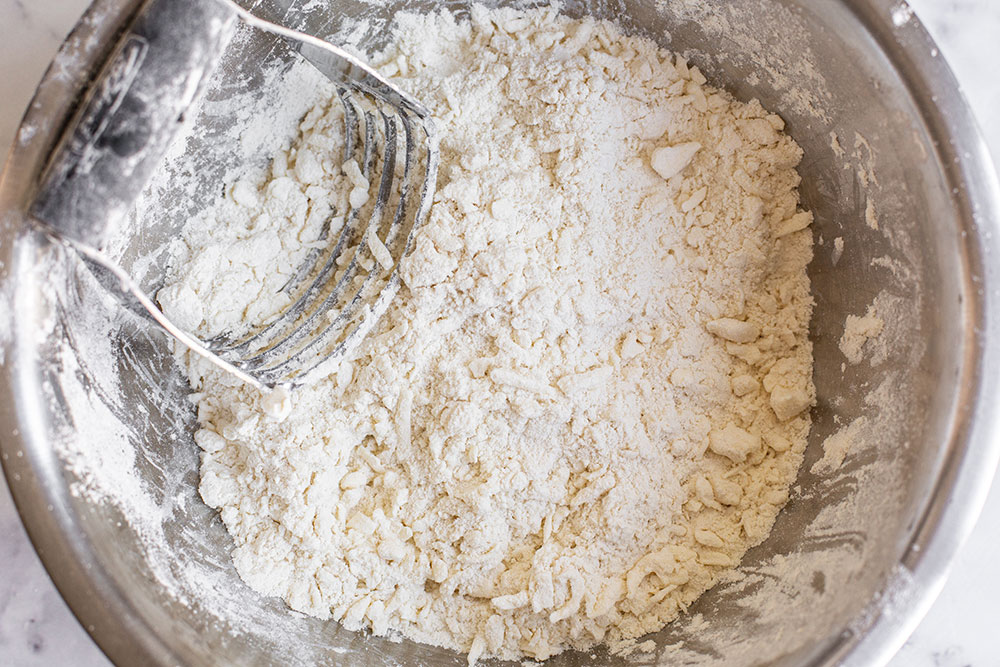
Method 2: Food Processor
Since I live in Phoenix where temperatures often exceed 85°F, I typically use a food processor to make pie dough. It’s quick, easy, and prevents the butter from warming up too much. Cube your sticks of butter with a bench scraper and freeze until firm. Add into the dry ingredients in the bowl of the food processor with the butter and pulse until the butter is the size of peas.
You want the butter to end up the size of little peas. This will help bring the dough together cohesively without overworking it.
Overworking the pie dough develops more gluten, which can make the baked crust tough and dense instead of light and flaky. This can also cause the crust to shrink while it’s baking. Additionally, overworking the dough with your hands can start to melt the butter, preventing that flaky texture from forming.
Creating pea-sized bits of butter will also prevent the butter from pooling into greasy puddles as the pie bakes. I used to use larger chunks of butter and would encounter these grease pools too often, so I’ve scaled back to much smaller pieces.
How Much Water to Use For Pie Dough?
This is one of the trickiest parts of making pie dough. The reason is that many factors affect how much ice water you’ll need to add, such as the climate and humidity of your kitchen and the brand of flour you’re using. That’s why the recipe calls for a range of water. Add half of the total amount to start with. Toss it in to combine either by hand or with a few pulses of the food processor.
Pick up a piece of the mixture and pinch it between your fingers. It should hold its shape. If it crumbles away or seems really floury and dry, then you need to add more water.
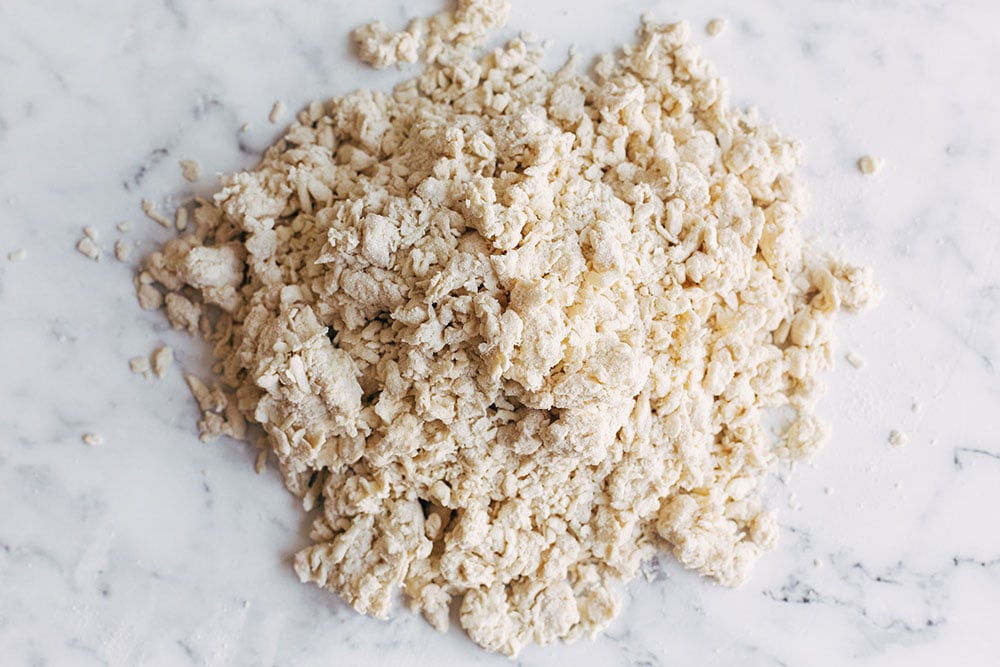
At this point, I like to turn the mixture out onto a work surface and begin pressing it together into one messy lump of dough. Doing so will give you a better indication if you need to add more water.
The dough won’t look like much at first. It’ll be kind of craggly and messy looking, and that’s okay.
Once you have a fairly cohesive mound of dough, flatten it into a disk and fold it onto itself, kneading gently as you work.
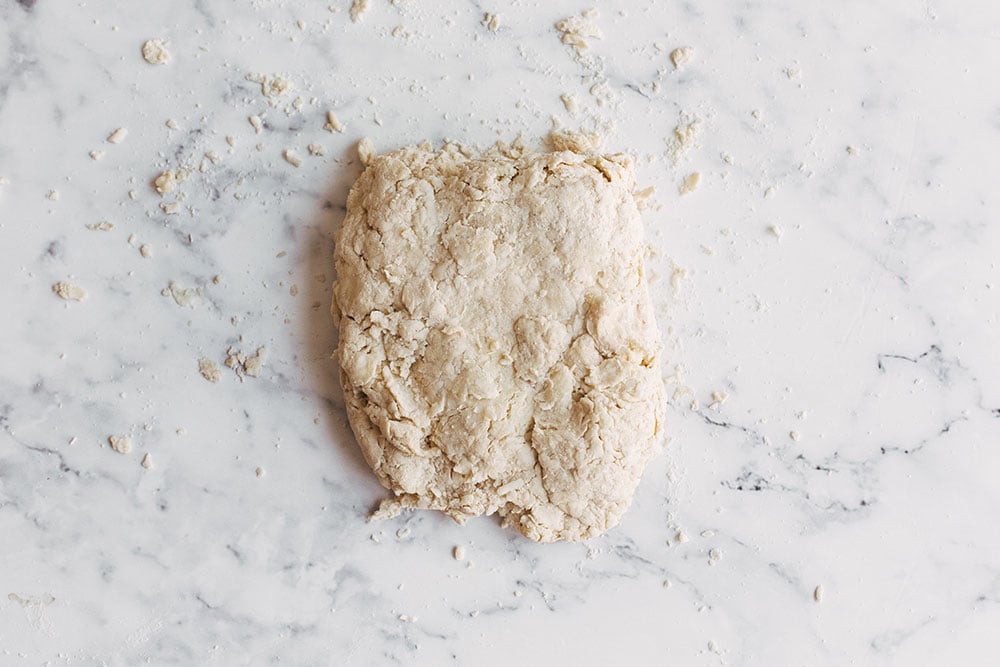
Do this a couple of times to ‘laminate’ the dough. Every fold will give you more flaky layers. Just be careful to be gentle and work the dough only until it comes together into a smooth cohesive disk like this:
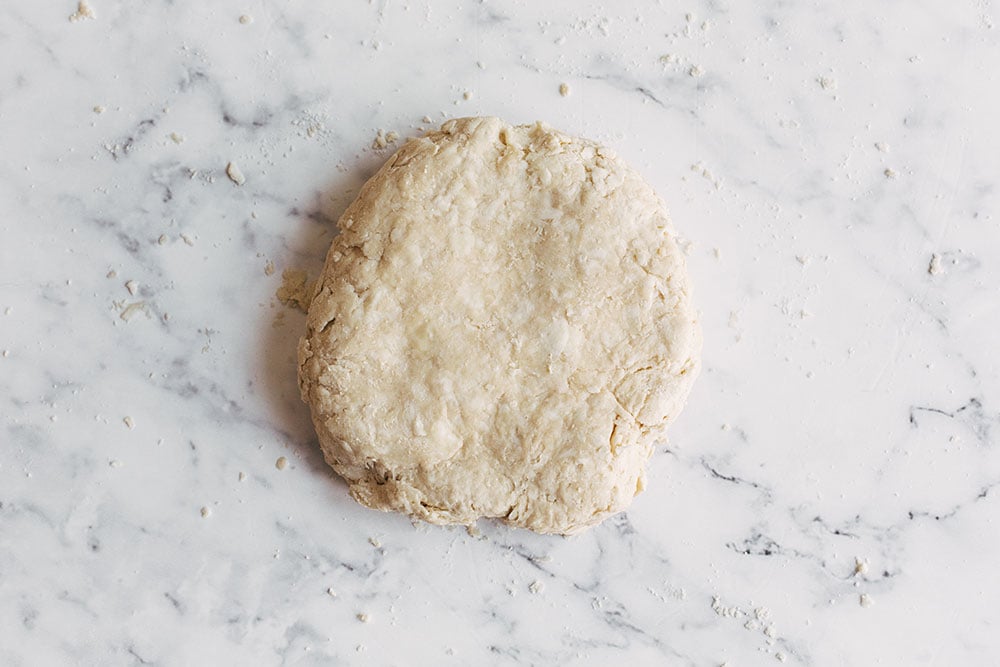
If you were to cut the mass in half, such as for a double-crust pie, you can visibly see the layers of butter thanks to that extra folding step. These layers are going to bake into crispy, tender, flaky goodness:
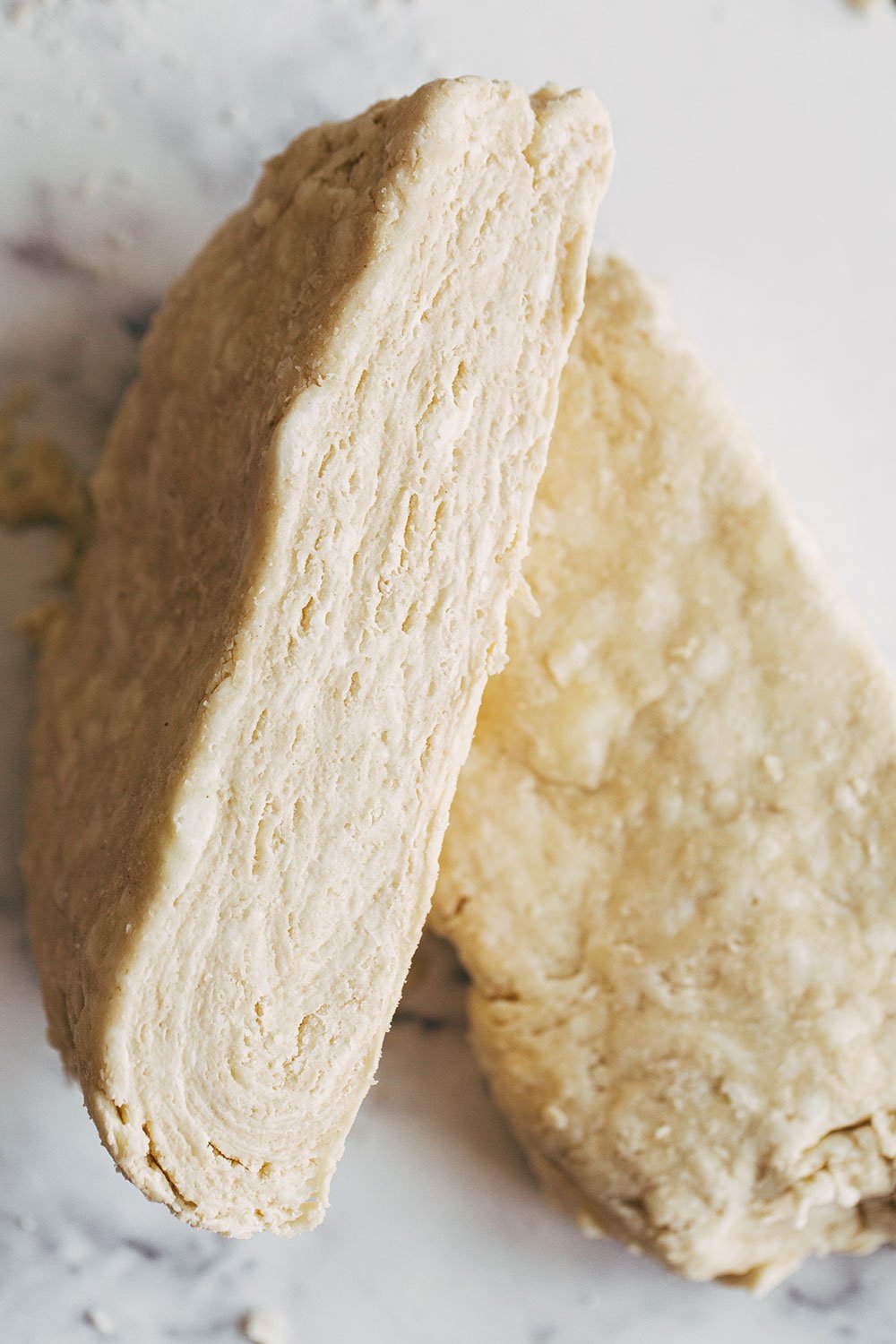
Give the Dough a Rest
If you have problems with your crusts shrinking while baking OR if your crust becomes tough, then it needs more time to rest so the gluten can relax so it doesn’t snap back to its original smaller shape. I’ve included these resting periods in the recipe directions.
After mixing it: wrap it in plastic and refrigerate overnight. You can shorten this to a few hours if you must, but I find overnight really makes a difference in preventing classic pie issues.
After rolling it out: let it rest in the fridge after you’ve rolled it out and placed it in the pie dish and/or after you’ve assembled. Do NOT stretch the dough to fit into the tin, as it will snap back like a rubber band while baking.
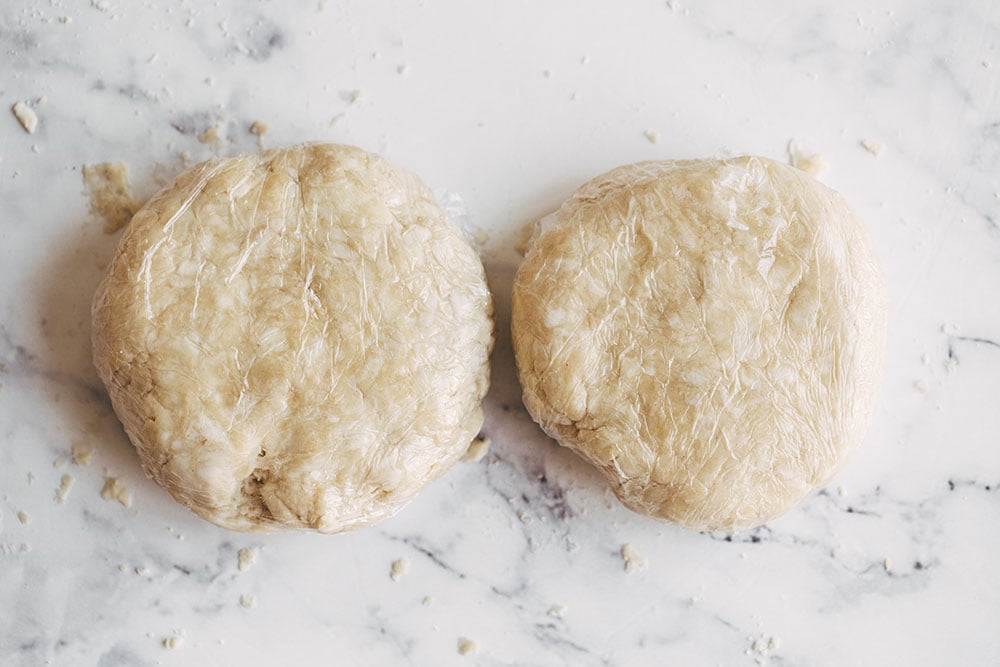
Now let’s move on to the other area of pie crust that I think frustrates a lot of people.
How to Roll Out Pie Dough
I typically roll out my dough on a marble pastry board, but that is totally optional. You can use the trick I mentioned above of icing down your counter before rolling to help keep things nice and cool. Avoid overworking the dough as you roll it out. Keep the dough moving on a lightly floured surface so you don’t roll over the same areas repeatedly, making it tough.
You’ll want about a 12-inch diameter for a 9-inch pie pan. Some pans are deeper than others, so factor that into your rolling. Whatever you do, make sure the thickness is about 1/8-inch for your pie crusts. Thinner will result in rips and tears. Thicker and it won’t cook through and get flaky.
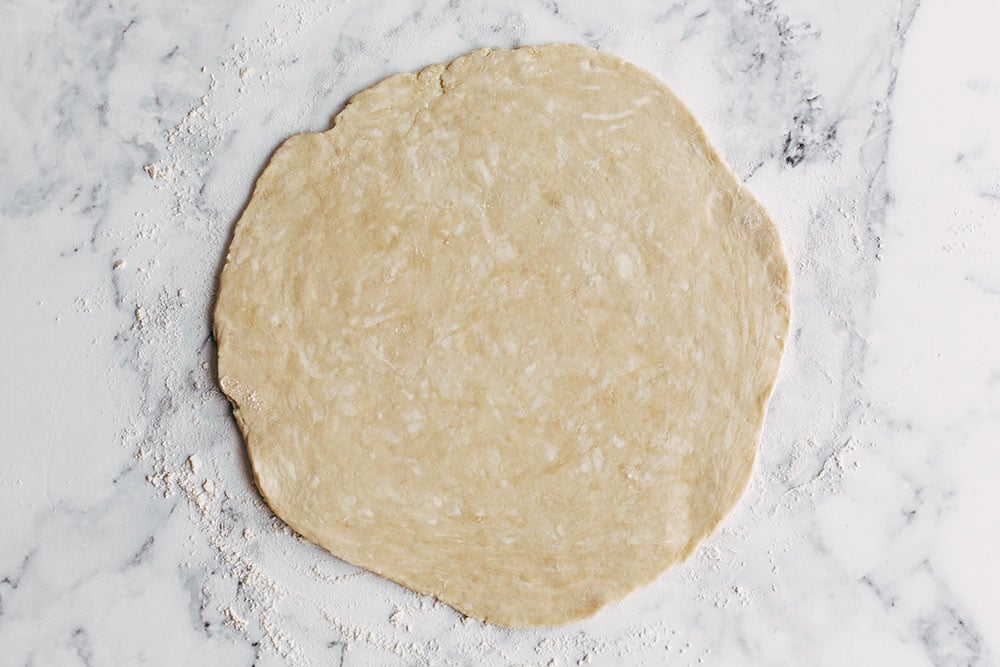
Flour your work surface, the dough itself, and your rolling pin throughout the process as needed. There are two inexpensive tools that I find are both a MUST when it comes to rolling out pie dough: a flour shaker and a bench scraper.
The flour shaker allows you to easily add flour wherever sticking might be happening. The bench scraper allows you to easily keep the dough moving as you roll it out, which is essential. I keep the dough moving in quarter-turns to prevent sticking and to keep it an even thickness.
Alternatively, you can roll the pie dough out between two sheets of parchment paper or plastic wrap. I find that most non-commercial paper and plastic wrap isn’t big enough to accommodate a 12- to 14-inch diameter circle, so I don’t often use this method.
If at any point the butter begins to get melty and sticky, return the dough to the fridge immediately.
Use your fingers to flute the edges of the pan if you wish. I find that I need to make a more dramatic flute than I might think since the design will loosen during baking. Whatever you do, don’t make the flute too thick and heavy, otherwise it’ll slump down the sides.
More Dough Than Other Recipes?
You might notice in the recipe below that I call for more ingredients than other recipes. This is because I think it’s easier to work with dough when you have a little more than you may need. It comes together more cohesively and if you get any rips, tears, or make any mistakes with a design, you have extra.
This especially comes in handy if you have a deeper pie dish or if you want to get fancy with any designs.
Pie Crust: Butter vs. Shortening?
I’ve done an extensive amount of testing on pie crust. Let’s just say my kitchen has seen a LOT of butter. I made the messes and did the testing so you don’t have to. Here’s what I learned.
When it comes to pie dough, I’ve heard a lot of confusing and conflicting opinions about which is the better fat. If you’re curious, you can learn more about the general differences between butter and shortening here. But I actually tested the two fats in pie crust side-by-side to compare. I still need to do testing with lard, so stay tuned for that!
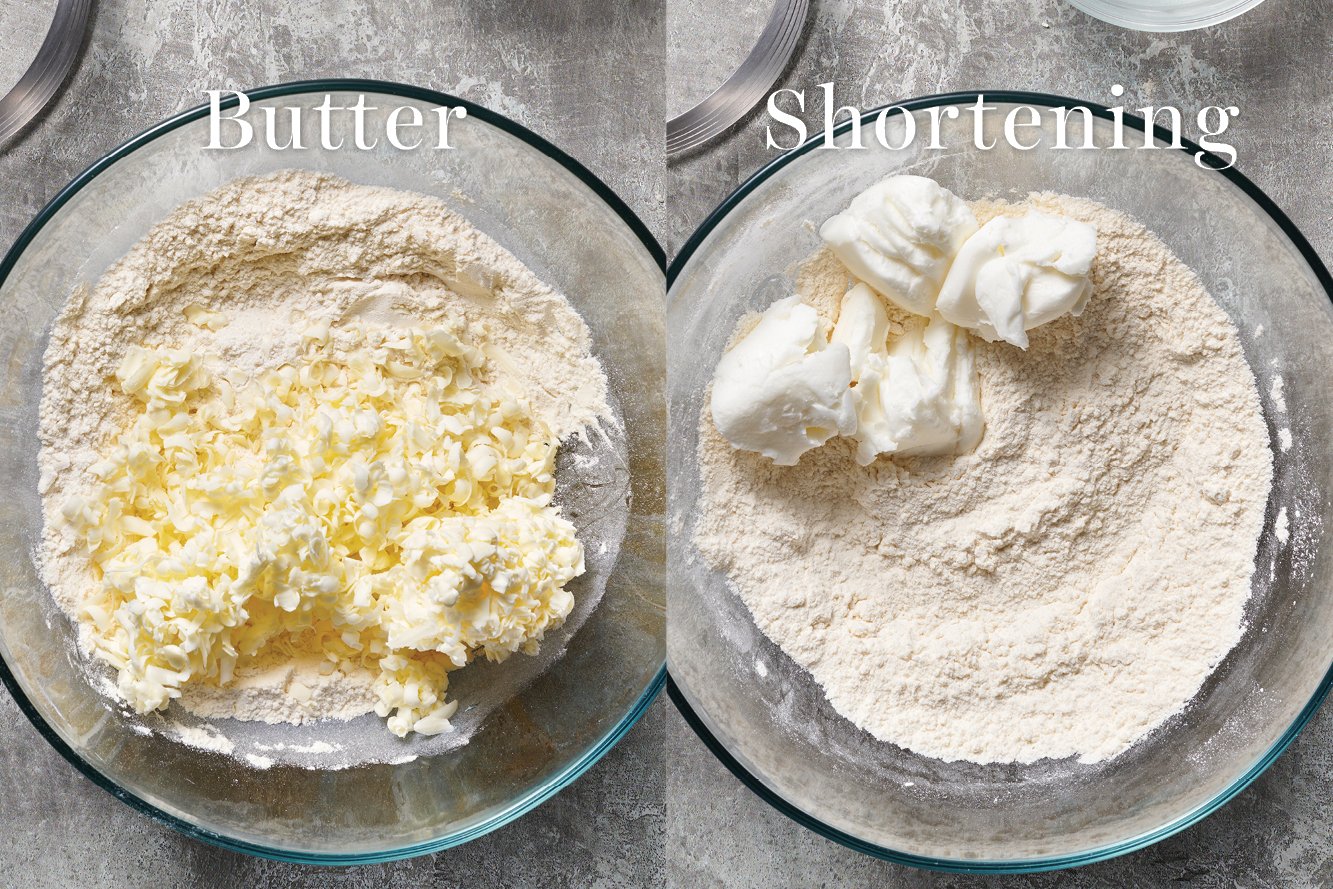
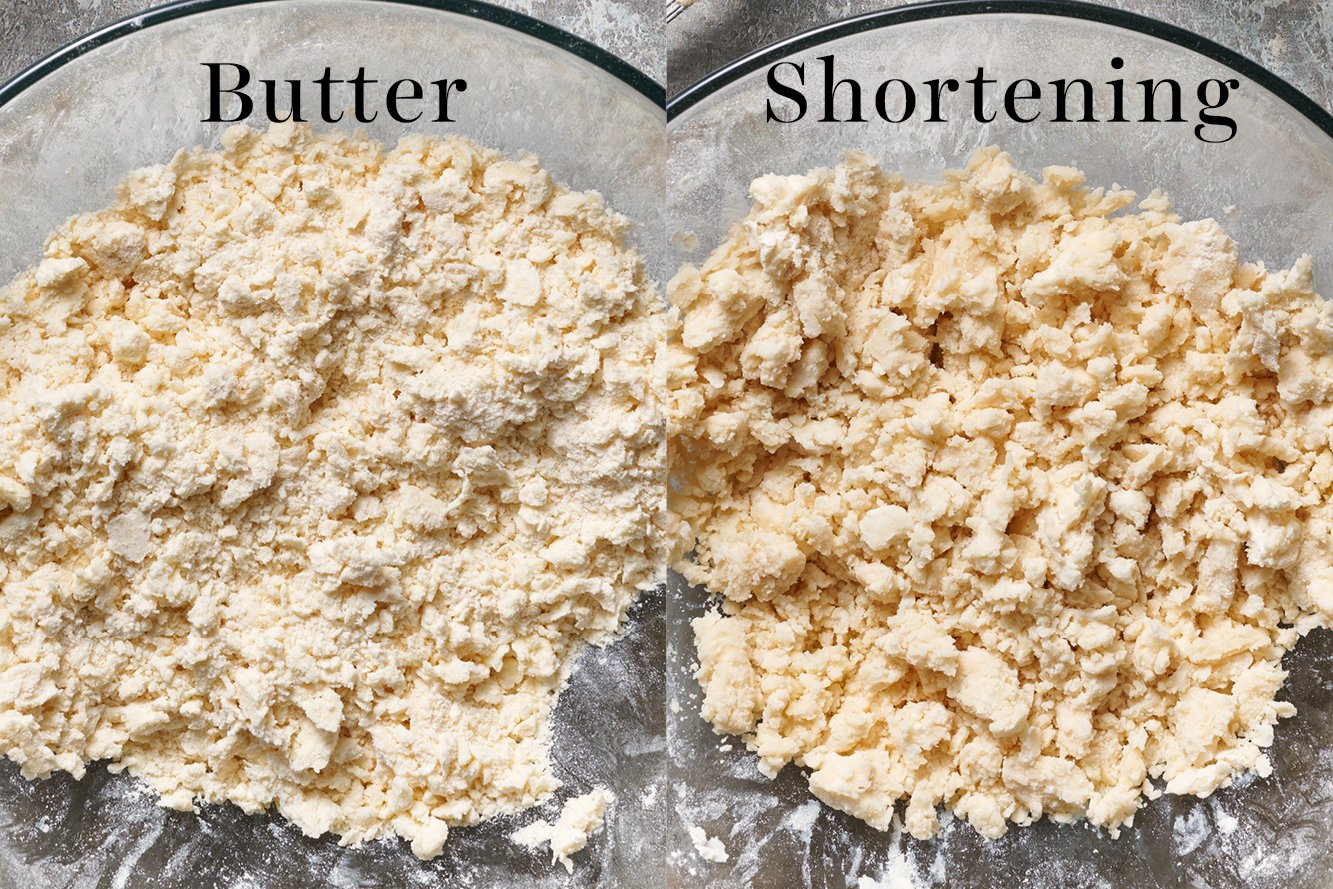

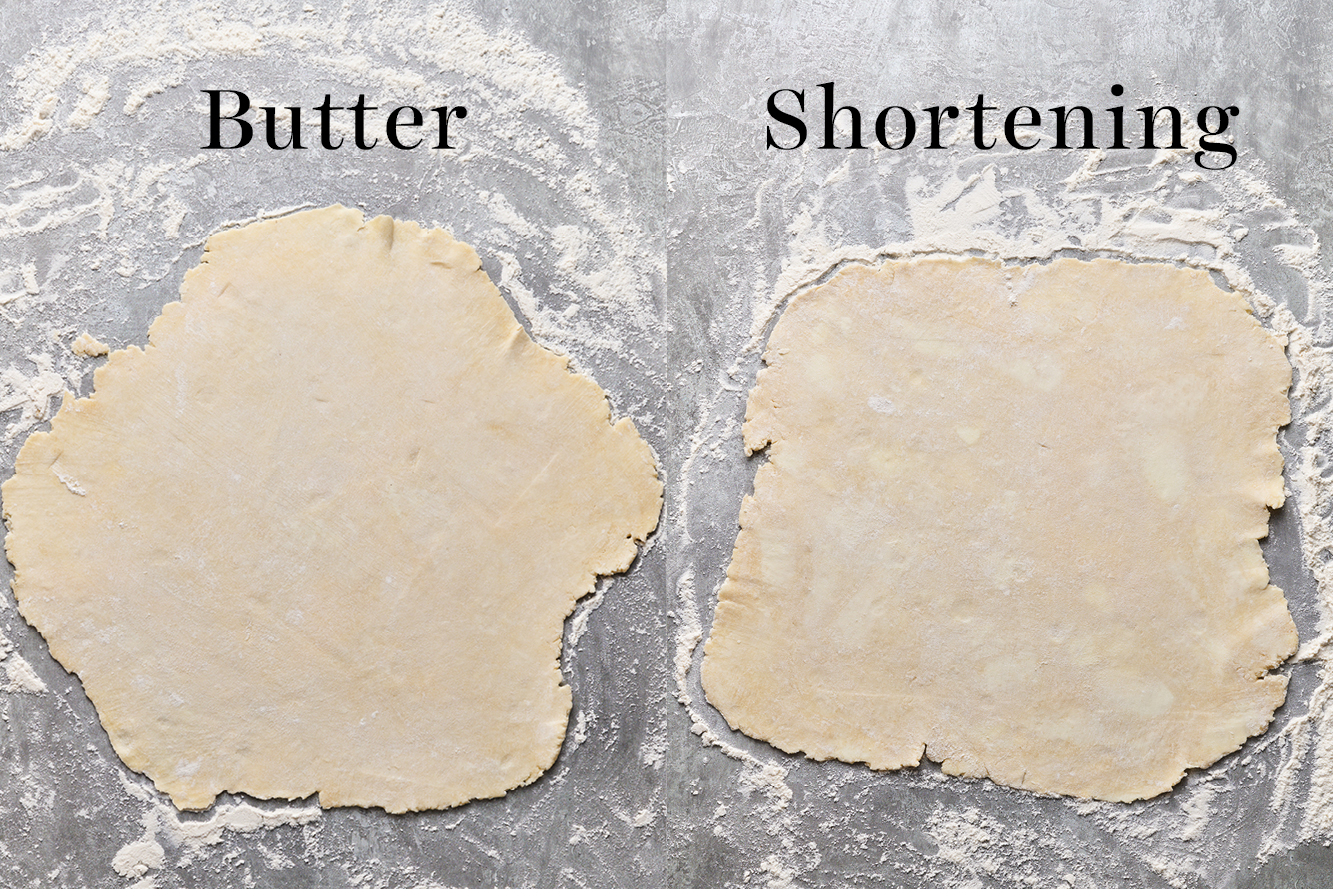
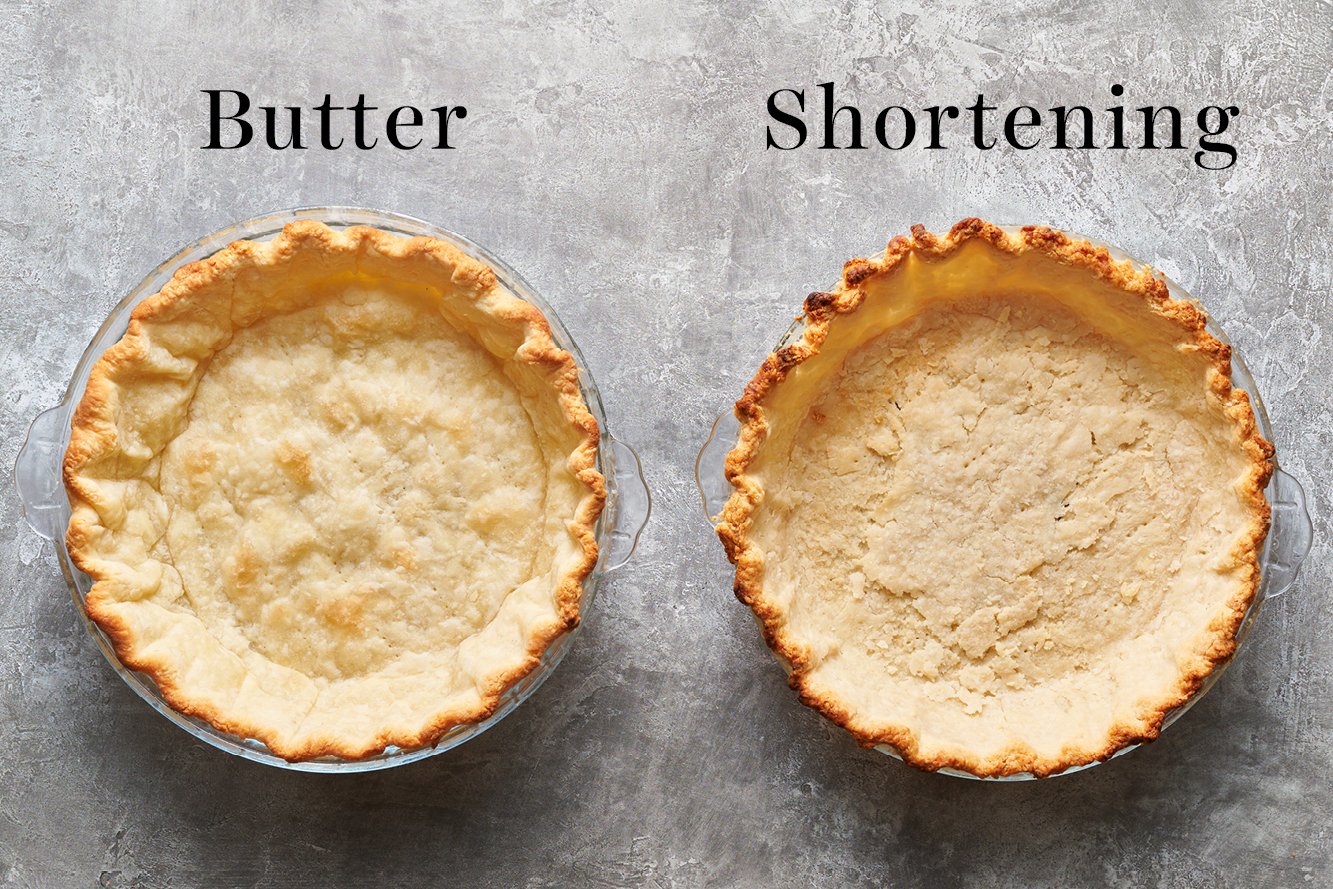
Shortening
All-shortening dough can be easier to work with in one sense because unlike butter, shortening requires less chilling time. Shortening has a higher melting temperature than butter. However, this also means that unlike the very hard chunks of cold butter that remain in the control dough, shortening is soft enough that it is easily overworked, resulting in a crumbly crust instead of a flaky crust. In our blind-baked shortening crust, the parchment paper holding the pie weights actually stuck to the crust, pulling some of it off with it.
As you can see in the photograph, the all-shortening dough ended up being flat, tender, and fairly crumbly. The texture was actually reminiscent of shortbread, and it was completely lacking in flavor. In fact, the flavor reminded me of store-bought dough.
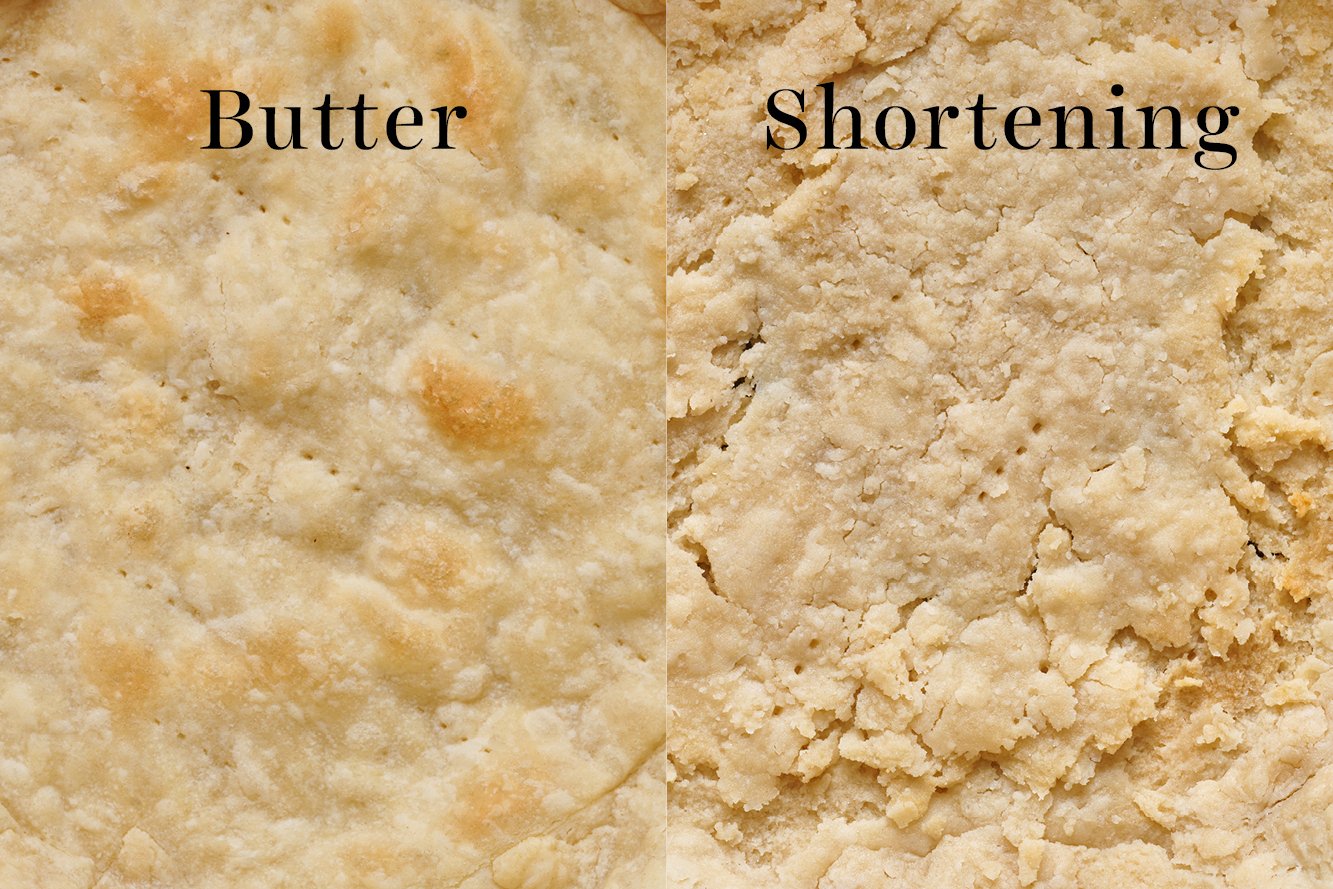
Butter
In this all-butter dough, there were plenty of visible chunks of butter studded throughout. Once it came together and was chilled, it was a bit of a challenge to maintain that perfect temperature where it’s warm enough to shape but cold enough that the butter doesn’t melt. Especially for me living in the desert. The extra effort paid off immensely, though. This pie crust was ridiculously light, flaky, and loaded with rich buttery flavor. You could immediately tell this was homemade, in the best way. This is why I almost always prefer a 100% butter pie crust.
If you like the benefits of shortening, then I’d recommend a 50-50 ratio of butter and shortening to get the best of both worlds.
Other Pie Crust “Tricks” Put to the Test
Vodka in Pie Crust?
A few reputable sources have claimed that by substituting a portion of the water with vodka in a pie crust recipe, you prohibit gluten development and therefore ensure a tender, flaky crust. I tested this against my standard pie crust recipe and found the differences to be slight. I don’t think it’s worth the extra effort if you don’t have chilled vodka on hand.
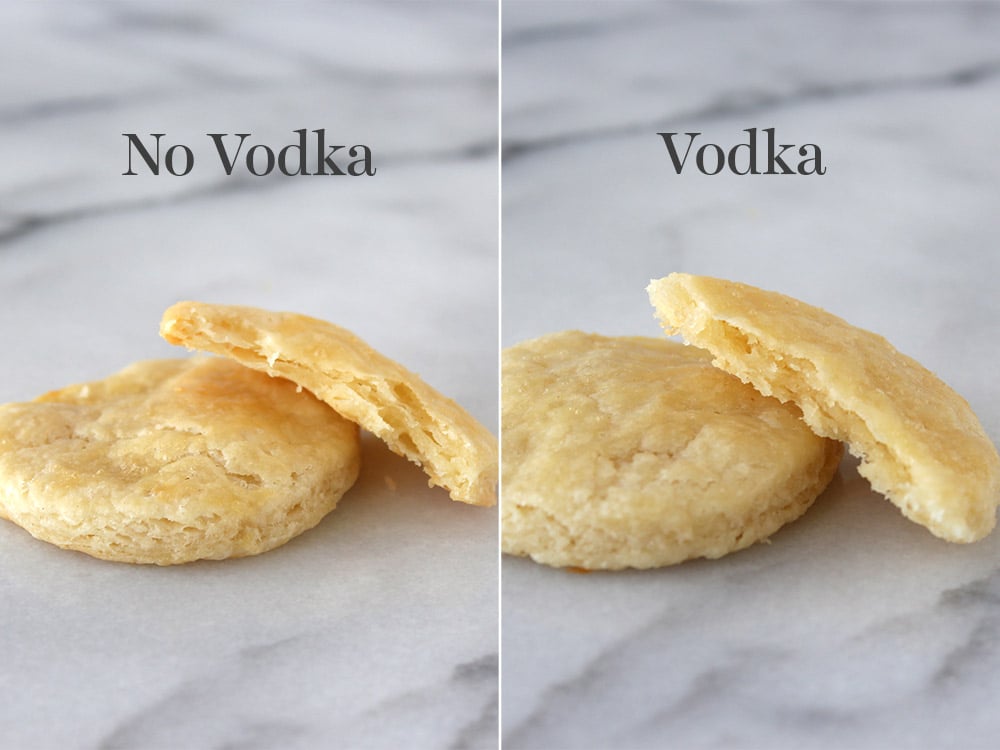
Optional SECRET Ingredient!!
As you can see, I’ve done a lot of side-by-side testing of pie crust variations. Most of the time the classic recipe has won out, with a single exception: SOUR CREAM!
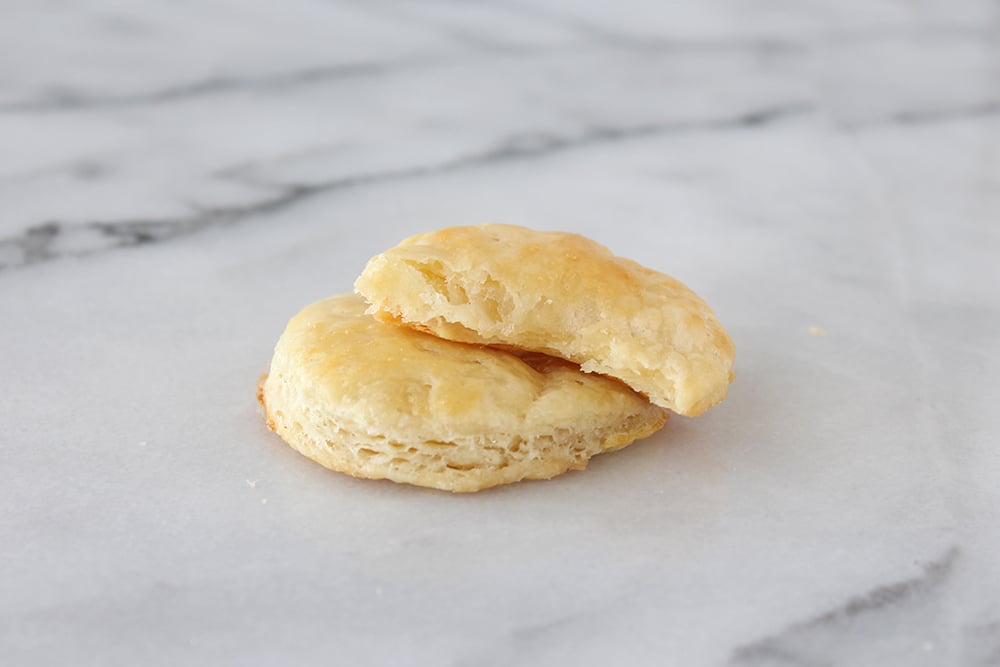
Sour cream acts as a tenderizer in baked goods, and I was curious to see if it would significantly affect the texture of pie crust.
- I added 2 tablespoons of sour cream to my standard single recipe along with the butter.
- This dough was very soft and slightly sticky, but easy enough to work with.
- The texture was ultra-light, puffy, and flaky, almost like puff pastry.
- This pie crust puffed up to a surprising height.
- If you have sour cream handy, I definitely suggest giving it a shot.
How to Add Sour Cream
Add in 2 tablespoons to the single recipe below, and reduce the water by about 2 tablespoons, or as needed.
Can you Make Pie Dough Ahead of Time?
Yes! Here are your options:
1. Chilling the dough disk: Pastry dough can be shaped into a disc and refrigerated for up to 3 days, as long as it’s well wrapped in plastic.
2. Chilling the unbaked pie shells: Refrigerate for up to 3 days. Simply roll out your dough, lay it into your pie tin, crimp the edges, and cover loosely with plastic wrap. When ready, simply remove from the fridge, fill, and bake. This works perfectly for single-crust pies like pumpkin or sweet potato.
3. Freezing dough: Pastry dough can also be shaped into a disc and frozen for up to 2 months, well wrapped in plastic, and placed in a freezer bag or airtight container. Defrost in the fridge overnight before rolling out.
4. Freezing pie shells: Unbaked pie shells can also be covered and frozen for up to 2 months. No thawing necessary.
How to Bake Pie Dough
I’ve included instructions on how to blind-bake the crust for recipes that require an already-baked crust. Otherwise, just follow the directions in the pie recipe you’re following for baking the crust – or, check out my full article on How to Blind Bake Pie Crust here!
The Best Pie Pan for the Best Pie Crust
The material of your pie pan can make a big difference in how your pie bakes. I recently used this Best Ever Pie Crust recipe to experiment with different pie pans, to determine which pie pan is best. Check out my Best Pie Pan article here to see my side-by-side experiments using glass, ceramic, metal, and disposable pie pans, and learn which pie pans I recommend.
Expert Tip!
Place your pie pan on a rimmed baking sheet before putting in the oven. This helps you to remove the pie tin without damaging the crust with your oven mitts. Better yet? Place the sheet on a BAKING STONE to ensure a golden crispy bottom crust and avoid any sogginess.
Check Out These Pie Recipes:

Become a Baking Genius!
Sign up for our free email newsletter for NEW recipes & baking science secrets.
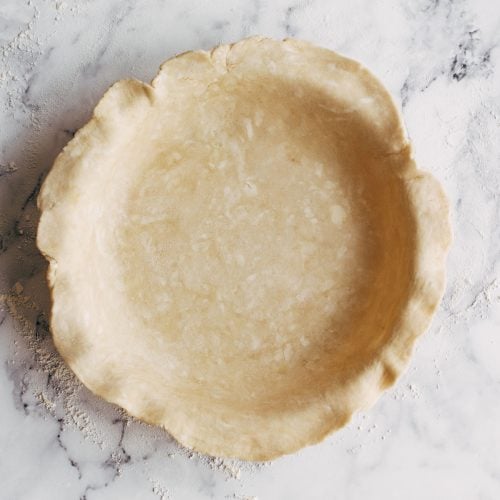
Best Ever Pie Crust
Ingredients
Single crust:
- 1 1/2 cups (191 grams) all-purpose flour
- 1 tablespoon granulated sugar
- 3/4 teaspoon fine salt
- 10 tablespoons (142 grams) cold unsalted butter
- 4 to 6 tablespoons ice cold water
Double crust:
- 3 cups (381 grams) all-purpose flour
- 2 tablespoons granulated sugar
- 1 1/2 teaspoons fine salt
- 2 1/2 sticks (284 grams) cold unsalted butter
- 1/2 cup to 3/4 cup ice cold water
Instructions
Make the dough:
By hand:
- Freeze your butter for 10 minutes, or until very cold. Grate the butter using the large holes of a box grater (or using the grater attachment of your food processor – see below). Return grated butter to freezer for another 10 minutes. Alternatively, you can also shred frozen butter into shards using a sharp knife.
- In a deep, medium-sized mixing bowl, combine the flour, sugar, and salt. Add the cold grated butter, tossing to combine. Working quickly, use your hands to further cut and break the butter into pieces the size of small peas. You can also use a pastry blender or two knives.
- Drizzle a few tablespoons of water on the mixture and toss to moisten. Continue adding the remaining water until the dough sticks together and stays stuck when pressed between two fingers. It’s okay if the dough is still crumbly and messy.
- Turn the mixture out onto a clean work surface. Use your hands to press the dough together into a craggily mass. Gently fold one half of the dough over and onto itself, repeating this three times, until it’s come together into a cohesive mass.
- Use a bench scraper to cut the dough in half (if making double crust). Wrap each half in plastic. Press down each plastic-wrapped dough to create a 4-inch wide disk shape. Refrigerate at least six hours, preferably overnight.
By food processor:
- Freeze your butter until hardened, then use the grater attachment of your food processor to shred it. If you don't have the grater attachment, use a bench scraper to cube cold but not frozen butter into 1/2-inch pieces. Freeze the cubed butter for 10 minutes.
- In the bowl of a food processor, add the flour, sugar, and salt. Pulse a few times to combine. Add the cold grated or cubed butter and pulse for about 30 seconds, or until the butter pieces are uniform in size.
- Drizzle a few tablespoons of water on the mixture and pulse briefly a few times to moisten. Continue adding the remaining water until the dough sticks together and stays stuck when pressed between two fingers. It’s okay if the dough is still crumbly and messy.
- Turn the mixture out onto a clean work surface. Use your hands to press the dough together into a craggily mass. Gently fold one half of the dough over and onto itself, repeating this three times, until it’s come together into a cohesive mass.
- Use a bench scraper to cut the dough in half (if making double crust). Wrap each half in plastic. Press down each plastic-wrapped dough to create a 4-inch wide disk shape. Refrigerate at least six hours, preferably overnight.
Roll out the dough:
- Let the dough sit at room temperature for 5 to 10 minutes, or until slightly pliable.
- Roll the dough out on a floured work surface. Keep turning the dough after every roll to ensure it doesn’t stick to the counter and is of even thickness. Add additional flour to the dough, the counter, and your rolling pin as needed. Roll out into a 12-inch circle about 1/8-inch thick.
- Gently roll the dough up and around the rolling pin, then unroll and drape over a 9-inch pie tin. Gently press into the pie tin, being careful to avoid stretching it to fit. Use scissors or a knife to trim the excess dough, leaving a 1-inch overhang. Fold the overhang under itself and crimp or flute. Pierce the base of the dough with a fork.
- Repeat above rolling process if making a double crust pie.
- Wrap the dough in plastic and refrigerate for at least 2 hours, or overnight. At this point, consult your recipe directions for how to use the dough or follow options below.
Bake dough:
- If the pie recipe calls for a prebaked shell, preheat the oven to 425°F. For an extra crispy bottom crust, place your oven rack on the bottom shelf and if you have one, bake on a preheated baking stone.
- Line the chilled crust with foil. Fill the crust completely to the rim with pie weights, granulated sugar, rice, or dried beans.
- Place on a rimmed baking pan.
- To par-bake if baking again with filling:
- Bake for 15 to 17 minutes, or until just beginning to brown and no longer raw.
To bake completely:
- Bake for 20 minutes or until solidified. Remove foil and weights. Continue to bake until totally browned at the edges with light browning in the center, about another 7 to 10 minutes.
This post was originally published in 2017 and updated with recipe improvements, updated tips, and new photos. Photos by Ashley McLaughlin.
HTH Community Pies
Take a look at these pies using this recipe, all made by HTH community members – many of whom had previously struggled to master pie dough! Follow the tips in this article to bake pies that look like these:
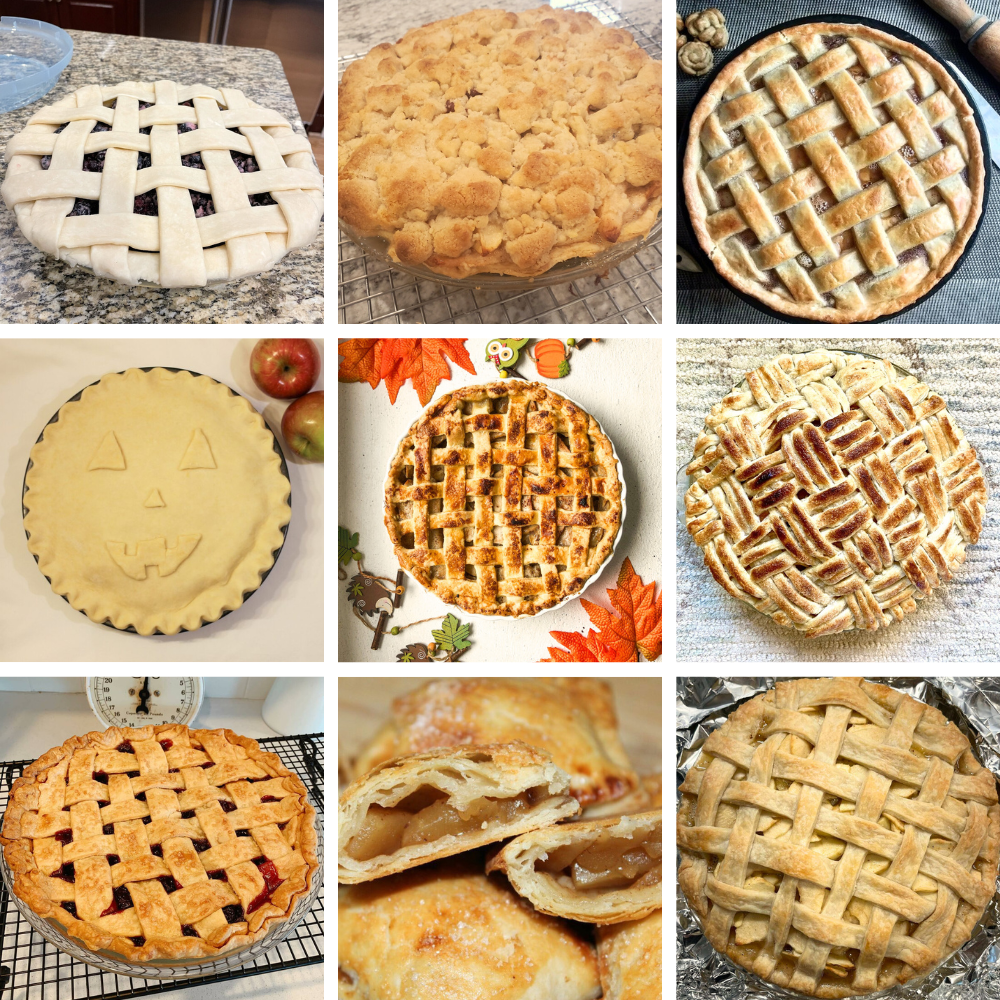

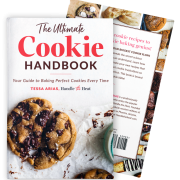



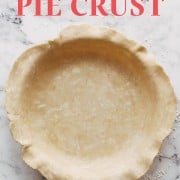
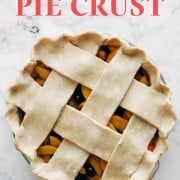
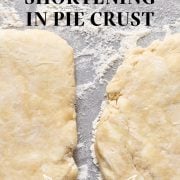
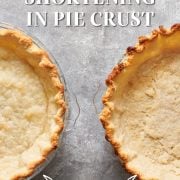
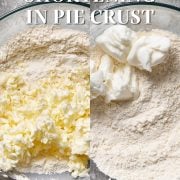
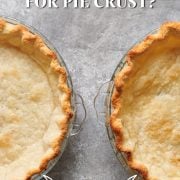
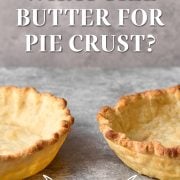
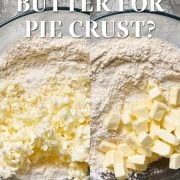
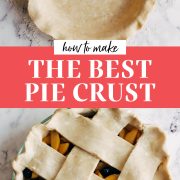
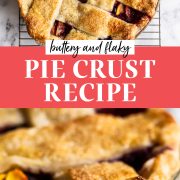
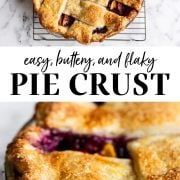
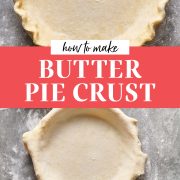

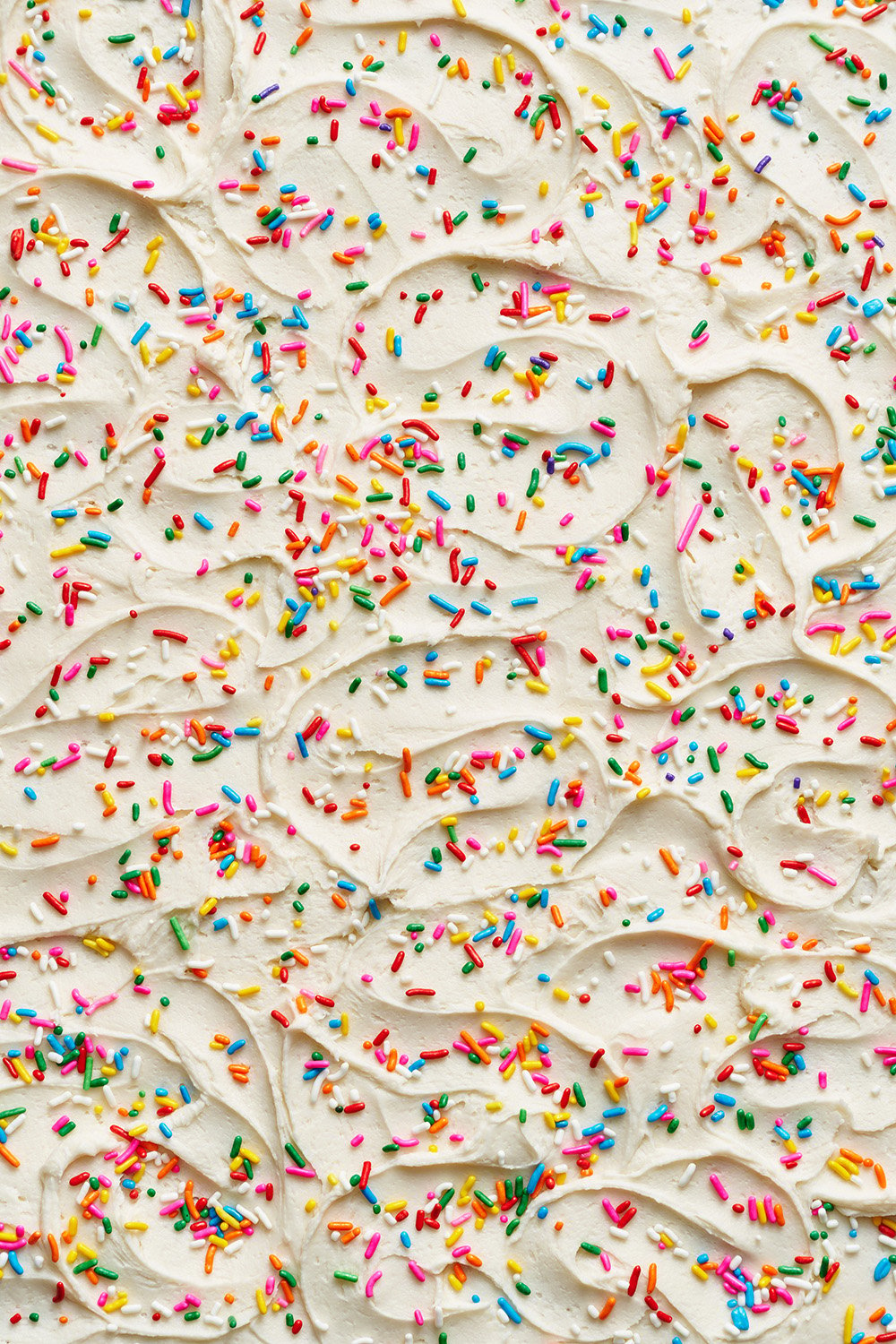
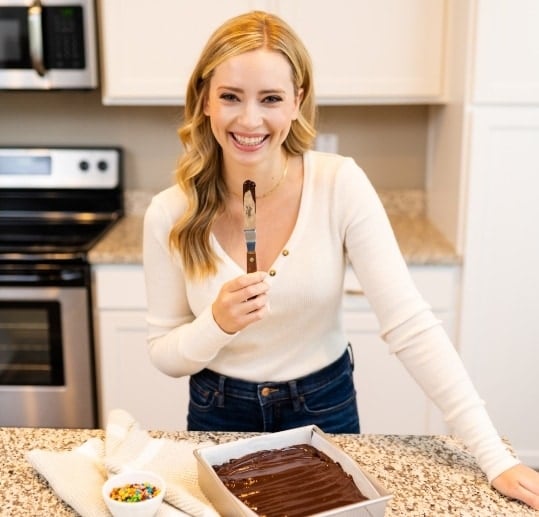
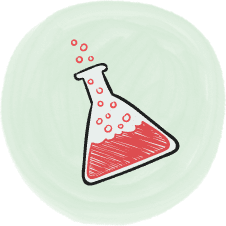

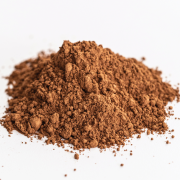
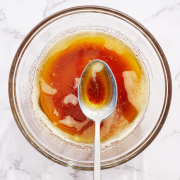
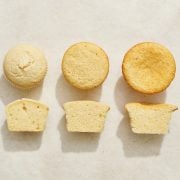
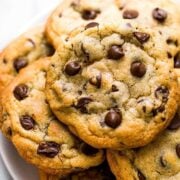

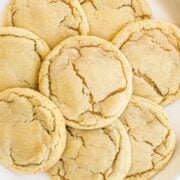
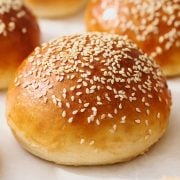








Made your recipe today and ended up with a sea of butter floating on the bottom. Help
Oh no! Pie crust can leak butter if your butter chunks are too large or if the dough wasn’t fully chilled before baking. Give Tessa’s baking tips above the recipe a read, and please let me know if you have any questions after. I’m happy to help, and I truly hope you give this another try. Good luck!
This pie crust recipe is excellent. Perfect results every time. It is very important to not overhydrate your dough, it’s okay if it seems a little dry (it’ll come together as you fold it over itself and let it chill in the fridge, I usually chill it 12-24 hours). I’ve found that setting aside the part of the dough that successfully sticks together, adding very small amounts of cold water to the dry and floury dough that remains in the bowl, and then combining them helps avoid the dough becoming too wet. Thank you for this recipe!
I made this recipe today
I followed exactly as printed
The crust turned out chewy. What happened?
Hi Rita! The most common mistake that leads to a chewy crust is overworking the dough, whether by overmixing it or overrolling it. I encourage you to check out our Baking Science tips section above this recipe, where Tessa goes into more detail about how to achieve a flaky pie crust. This is my favorite pie crust recipe, but it took me a couple tries to get it right, too! My biggest issue was I was adding too much water for my kitchen climate, then overmixing it. Once I better understood that step, my crust came out nice and flaky! 🙂 Please let me know if you have any other questions, we’re here to help! And let us know how your next attempt goes. Good luck!
I don’t see what temp to bake it at
Hi Debra! Check out step #16 for the oven temp 🙂 Can’t wait to hear what you think of our recipe!
I tried this- made the double crust, weighed everything, added 2TBS of sour cream in place of 2TBS of water (I didn’t realize that was only for the single crust). I had to add the entire rest of the 3/4 cup water, but rolled it out on a cool day on granite counters that I’d had freezer packs on prior. I had made the night before, and while I was patting each circle out it suddenly seemed like the butter got warm, but that part was not more than a couple of minutes. Placed in refrigerator overnight.
Seemed to roll out ok, baked nicely, it puffed up at least an inch up above the pie plate! I had more than enough and made a cinnamon sugar ‘elephant ear’ out of the scraps. The layering was impressive, and we were all excited. However, upon cutting (strawberry rhubarb), I could see that the sides and where the fold was did not bake through, and neither did the bottom, even though I had placed it upon a pre-heated aluminum baking sheet upon baking, and on it the entire time. I baked for a total of 75 minutes, obviously needed much more.
Also, upon eating, the flavor was great, but the bottom crust and parts of it were very tough. Not sure what I did wrong, I’ve been making pies for over 30 years, and always treat it like biscuit dough-barely handling it.
In retrospect, I’d cut it into thirds for three crusts, as I felt the crust could have been thinner and combined with the scraps I’d cut off, it seemed plenty. Not sure why it was so tough, other than the sour cream, or I overhandled it. Can’t imagine the latter, but clearly something failed.
Any ideas?
Hi Aimee! I’m sorry to hear that your pie crust didn’t turn out as expected! Without having baked alongside you, it’s difficult to say exactly what went wrong, but here are a few possible culprits:
– You mentioned treating the dough like biscuit dough and barely handling it, but it is possible that the dough was worked too much, leading to gluten development and a tougher texture.
– It could also be that your butter, during those few minutes you noted that you noticed it got a bit warm, was enough for some of the butter to melt just enough to prevent flaking and instead become a bit tough.
– You mentioned that you baked the pie on top of a pre-heated aluminum baking sheet – but where in the oven did you bake the pie? Unlike most bakes, pies can benefit from being baked on the bottom rack, close to the heat source. This can help the crust on the bottom to bake through better and crisp it up a little. You could also try baking on top of a preheated pizza stone, if you have one, to help that heat conduct even better.
– Lastly, your observation about the crust being thicker in parts could be the culprit here. Thicker crusts can take longer to bake, which allows the butter to melt without flaking, or prevents it from cooking through properly, resulting in a tough texture.
Hopefully something here helped! Feel free to reach back out to us with any further questions – we are always happy to help!! 🙂
Is it ok to make the disc 8″ before refrigerating overnight?
Hi Ariel! That should be fine – just make sure to wrap it tightly in plastic wrap and place it in an airtight container to prevent it from drying out in the refrigerator. Hope this helps! Happy baking 🙂
Hello… again:) I just asked a question on the blueberry pie recipe 🙂 For the flour, could I use one that has no enzymes? Just straight milled hard wheat all purpose flour? I spose as long as it’s “all purpose” on the label, it should work?
Hi Taryn! We haven’t tested this pie crust recipe with that type of flour, so I can’t say for sure. Tessa typically recommends using Gold Medal Bleached All-Purpose Flour in her recipes. Since different brands of flour vary in protein content, I can’t guarantee how this type of flour will affect your pie crust, but feel free to experiment with that variety and please let us know how it goes! Happy baking 🙂
Hands down the best Pie crust recipe I have ever made. Will only use this one from here on out. My husband came home and was blown away. Sent pictures to his coworkers, lol. Thank you for the timely responses. I used a spring form pan as well. Super pleased.
Is this pie crust for sweet pies as well as savory pies?
Hi Liberty! We have typically only used this pie crust recipe for sweet pies, but it would be delicious for a savory pie, too. Feel free to omit the sugar if desired. Let us know what you think of this pie crust recipe once you have given it a try 🙂
All I have done so far is read this article. It is SO clear and coherent, and even a “good read.” My wife, who bakes about 50 times more often than I do, makes an ordinary crust with some spices added. Tastes very good but pretty flat and the rims are tough. This recipe appears to address that and I am going to try it. If I am clear and coherent enough I will report further. Thank you!
Thank you for this recipe. I used my old stndard Crisco for many years until I realized my crusts weren’t as good as they used to be. That’s when I noticed Crisco is now made with soybean oil! Your crust is a lifesaver! I’ve started making pies again!
HELP I have a question. My butter is going back into the freezer until I get an answer.LOL I wanted to know when grating the butter with the large holes do you use 1 cup of the grated butter because I froze exactly 1 cup of butter and when I grated it I ended up with 4.5 cups of grated butter.
Hi Shelley! You will still use the whole two sticks of butter. This is one of the reasons we believe so strongly in weighing your ingredients, rather than using volume/cups – it takes the guesswork out of such instances. Learn more about weighing ingredients here. I hope that helps, and I hope you enjoy your pie! Happy baking 🙂